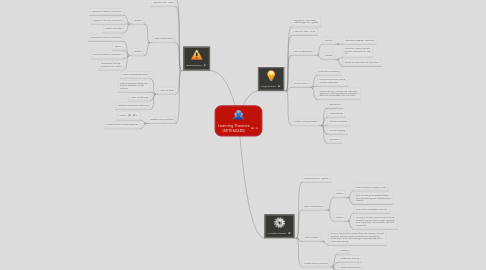
1. Behaviorism
1.1. Key person: B.F. Skinner
1.2. Major era: 190s - 1950s
1.3. Roles of stakeholders:
1.3.1. Teachers
1.3.1.1. Dispenser of reward or punishment
1.3.1.2. designer of learning environment
1.3.1.3. present information
1.3.2. Students:
1.3.2.1. Recipients of reward or punishment
1.3.2.2. Passive
1.3.2.3. receiver of reward or punishment
1.3.2.4. demonstrate that they understand the material
1.4. What it is about
1.4.1. Learner responding to stimuli
1.4.2. Define learning as nothing more than the acquisition of new behavior
1.4.3. Classic conditioning
1.4.4. Behavioral or operant conditioning
1.5. Possible learning activities
1.5.1. Practice
1.5.2. Reinforcement of correct responses
2. Cognitivism
2.1. Key persons: Jean Piaget, Robert Gagne, Lev Vygotsky
2.2. Major era: 1960s - 1970s
2.3. Roles of stakeholders
2.3.1. Teachers
2.3.1.1. information dispenser, transmitter
2.3.2. Students
2.3.2.1. information receiver, process and store information for later use
2.3.2.2. transfer and assimilate new information
2.4. What it is about
2.4.1. information processing
2.4.2. Focus on how human process and store information
2.4.3. Schema structure: compare new information against old, resulting combined, extended or altered to accommodate new information
2.5. Possible Learning activities
2.5.1. Explanations
2.5.2. Demonstrations
2.5.3. Illustrative examples
2.5.4. Concept mapping
2.5.5. Summaries
3. Constructivism
3.1. Represent person: Vygotsky
3.2. Roles of stakeholders:
3.2.1. Teachers
3.2.1.1. Guide, facilitator of academic tasks
3.2.1.2. focus on making connections between facts and fostering new understanding in students
3.2.2. Students
3.2.2.1. sense maker, knowledge constructor
3.2.2.2. Learning is an active process in which learner construct new ides based on past knowledge, social interactions, and motivation affect the construction
3.3. What it is about:
3.3.1. Focus on how learners construct their own meaning. They ask questions, develop answer and interact and interpret the environment. Then new knowledge incorporates with old to create new meaning.
3.4. Possible Learning activities
3.4.1. Modeling
3.4.2. Collaborative learning
3.4.3. Problem-based learning
3.4.4. Authentic learning
